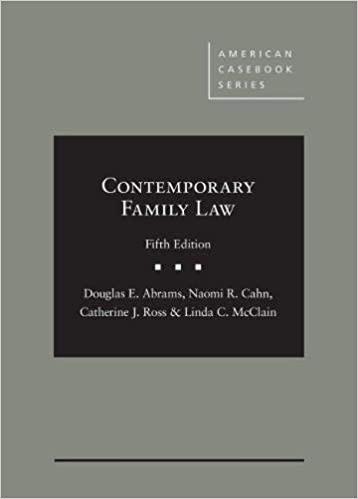Question
ALBERT Background of the case: Albert is currently charged with Unlawful Possession of a Weapon 3rd degree after he allegedly grabbed a kitchen knife and
ALBERT
Background of the case: Albert is currently charged with Unlawful Possession of a Weapon 3rd degree after he allegedly grabbed a kitchen knife and swung it at his mother during an argument. She was able to avoid injury by locking herself in her room and calling the police. On the Risk Screening Tool, he scored for placement in a detention alternative program and was released to his father's home on an ankle bracelet. Prior to this morning's hearing, the public defender met with him to discuss the facts of the case, and to let him know what evidence the Prosecuting attorney currently has. He also explains that the Judge has the discretion to decide whether or not to release him from the alternative program. He shares the list of recommendations made by the Prosecutor in the plea offer, and they discuss whether or not to accept the plea offer and plead guilty at today's hearing. He reminds Albert of his constitutional rights at trial (the right to confront witnesses, the right to testify on his own behalf, the right against self-incrimination, the right to have representation by an attorney, etc).
When Albert enters the court room, the following happens:
- The Prosecuting attorney reminds the court of the information in the juvenile complaint (including a statement of the charge and a description of events given by the arresting officer) and presents a summary of the evidence they have gathered so far to show that Albert committed the offense. He notes that Albert is currently serving a 6-month term of juvenile probation, which he is about halfway through, for a disorderly person- Shoplifting offense. The Prosecutor reads the plea offer into the court record: 1 year of probation, attend school daily, complete 20 hours of community service, comply with fingerprinting and DNA testing, and have no contact with the victim. He also notes that Albert's mother, who is the alleged victim of the incident, reports that Albert regularly comes home well after curfew or even stays out all night sometimes, and she and Albert have a history of ongoing conflict in the home. Therefore, the Prosecutor argues that Albert should continue to be monitored by a detention alternative program until the conclusion of the case.
- The public defender says that Albert cannot accept the plea offer because he denies the facts about the incident that were just presented by the Prosecutor. He adds that Albert's 7-year-old brother witnessed the argument and claims that Albert raised his fist and swung at his mother, but he doesn't recall seeing a knife. The public defender then shares a report from the Electronic Monitoring program which verifies that Albert has had no program violations of infractions since his last court appearance, and he has now been on the detention alternative for 35 days. He argues that electronic monitoring is no longer necessary because Albert resides with his father, who reports that he and Albert have a very good relationship and he has no concerns about Albert following his house rules. He notes that Albert has a part-time job on weekends that his father has to drive him to because Albert isn't allowed to walk alone while in the detention alternative program, and he has good attendance in school. He also reports to his probation officer every week without fail.
- The Judge asks Albert if he understands everything that has been said and if he agrees with his attorney's statements. She then agrees to release him from the detention alternative program today but orders that he continue to attend school and his job consistently, report to probation as currently required, follow his father's house rules, and avoid any unnecessary contact with his mother. The matter is scheduled for another hearing in three weeks.
THIS IS MOST LIKELY AN EXAMPLE OF WHICH TYPE OF HEARING?
A. Adjudication hearing
B. Waiver hearing
C. Pre-Trial Conference/Status Conference
D. Disposition hearing
Step by Step Solution
There are 3 Steps involved in it
Step: 1

Get Instant Access to Expert-Tailored Solutions
See step-by-step solutions with expert insights and AI powered tools for academic success
Step: 2

Step: 3

Ace Your Homework with AI
Get the answers you need in no time with our AI-driven, step-by-step assistance
Get Started


